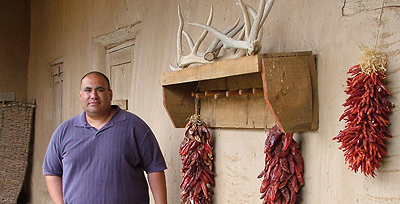|
Robert
Castro Awarded Yale Fellowship to Study Slavery of American Indians |
|||||
|
|||||
|
September 1, 2005 Decades before the first African slaves were sold in America, Spanish slave hunters crossed the Rio Grande in search of Indians to seize and enslave. Some were kept as personal servants while others were sent as “gifts” to Mexico City. This servitude kept American Indians enslaved for centuries. Recently, Robert Castro, assistant professor in Chicana and Chicano studies, was awarded a Post-Doctoral Associate Fellowship from Yale University’s Gilder Lehrman Center for the Study of Slavery, Resistance and Abolition. The award includes a cash stipend, residency at Yale University, and a public lecture based on his research. Six scholars from across the nation were selected for this prestigious fellowship that focuses on issues related to slavery. “I was both honored and thrilled to be awarded this fellowship,” said Castro, who joined Cal State Fullerton in 2002. “I had several important people — like Dean Jonathan Simon from UC Berkeley Law School, Noga Morag-Levine from Michigan State University Law School, and Isaac Cardenas from Fullerton that wrote strong letters on behalf of my research to Yale University. “Interestingly, when most people hear the term ‘slavery’ as it relates to America, they immediately imagine Africans brought here and sold as property,” Castro said. “Yet slavery in America also had its origins in the treatment of Indians by the Spanish who arrived here.” With a degree in law, Castro decided to focus on the legal ramifications of Indian enslavement when conducting research for his doctorate in political science. Because of the number of legal memos and documents in New Mexico, he concentrated his dissertation research on the Southwest, particularly New Mexico. “It’s an interesting socio-legal puzzle,” he explained. “While there is a great deal of information about African slavery, little attention has been paid to how corresponding institutions, like Indian-mestizo servitude, impacted Indians and mestizos in the Southwest.” The United States Congress had been aware of servitude customs in New Mexico since 1847, but it wasn’t until the Reconstruction era (1865-70), that the government attempted to liberate Indian slaves from their owners in substantial numbers. “There was consensus that Indians were captured
and forcibly held in servitude, and often, their treatment was at
the whims of their captors,” said Castro. “They could
trade these captives as they would a mule or horse. They were sometimes
bartered like private property — especially women and children.”
Over time, servitude customs evolved to entangle poverty stricken
mestizos as well. “But federal liberation was largely unsuccessful for several reasons,” Castro explained. “There were few resources, little operational support, elusive slaving networks and a lack of manpower. This all contributed to a breakdown in attempts to liberate captive Indians. “In addition, Indians were used to establish the system,” the researcher noted. “Servants and New Mexican families had grown up with each other over generations. So even while Indians weren’t owned in the traditional sense, there was a dependency that was established. Borderland customs of ritualized servitude took root. Moreover, there may have been a sense among Indians and mestizos that functioning as servants was ‘their place’ in the order of things.” Castro believes there is a strong connection between historic slave systems, like Indian-mestizo servitude, and modern day activities like human trafficking. “Trafficking victims, like earlier captives, are routinely ‘chattelized’ and denied important liberty rights,” remarked Castro. During his January fellowship, Castro will focus his research on the government’s attitudes toward Indian enslavement. Did they believe this servitude was the same as black slavery? If so, did they attempt to create parallel enforcement programs to abolish the Indian-mestizo slave trade? If not, why not? “I believe that the government’s anti-slavery activities were focused on black slavery in the South, and this deeply affected the government’s priorities,” Castro continued. “Once freed, citizenship was bestowed on blacks ... but not Indians. Some believed that Indians and a result, they did not have actionable citizenship rights that the government was obligated to protect. So even though the Peon Bill was passed, there were few attempts to monitor its enforcement. “My project links two formerly segregated slave histories — black and Indian-mestizo — through the prism of federal civil rights law,” said Castro. “My hope is that this project will enhance public understanding of how racial paradigms sometimes collide with what we imagine law and history to be.” In his classes, Castro frequently explores the multilayered experience of Latinos, as well as the biological and cultural connections of mestizos to Indians. And he discusses his research with his classes. “It is amazing that the history of Indian-mestizo servitude is absent from most history books,” he said. “When we think of civil rights, it is clearly grounded in the black experience. Yet it can also rightly be applied to Native Americans, Chicanos and other delineated groups that have been stigmatized like African-Americans. “Unfortunately, these marginalized populations have largely been excluded from our nation’s public conversation on race. In many ways, we see civil rights through a black/white paradigm; the hidden history of Indian-mestizo slavery is an artifact of that process. Learning more about the enslavement of Indians and mestizos helps strengthen our understanding of how slavery functioned in America and worked itself into the fabric of our nation.” |
|
